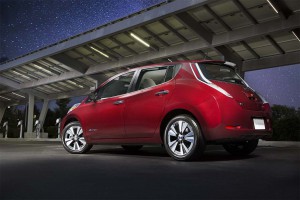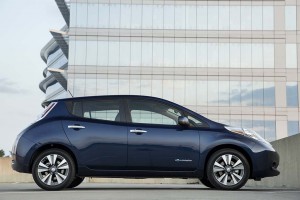The 2016 version of the Nissan Leaf will now be able to travel an estimated 107 miles between charges, a 27% increase over the original version of the battery-electric vehicle.
The Japanese maker is taking advantage of improvements in lithium-ion technology to squeeze a 30 kilowatt-hour battery into the 2016 model. Until now, the Nissan Leaf had used a 24 kWh pack. Nissan now claims to offer “best-in-class” range, and the numbers are better than such competitors as the Ford Focus EV that get less than 100 miles per charge. But it still lags well behind the much costlier Tesla Model S, as well as the 200-mile Bolt model Chevrolet is currently developing.
“We know that to maintain that leadership, we must continue developing battery technology that strikes that ideal balance between capacity, packaging, durability and affordability,” said Andrew Speaker, director, Nissan Electric Vehicle Sales & Marketing.
While critics say the technology isn’t evolving fast enough, proponents note that lithium batteries are becoming more powerful, smaller and less expensive. Where lithium-ion batteries were running as much as $1,000 a kWh when the Leaf came to market in late 2009, industry insiders say that has dropped to as little as $400 today. The goal is to reach $200 or less before decade’s end.
(Luxury makers take aim at Tesla with new extended-range battery-cars. Click Here for the story.)
For 2016, a Leaf S with the current, 24 kWh battery will hold its base price – before federal and state tax incentives – to $29,860. That includes $850 in delivery charges. Range remains 84 miles.
The new, 30 kWh pack will be standard equipment in more SV and SL premium versions. The 2016 Nissan Leaf SL will start at $35,250, including delivery, while the SV base price will be $37,640. All models are eligible for a $7,500 U.S. tax credit and other local and state incentives.
The 2016 model will retain the same powertrains as in the 2015 Nissan Leaf, an 80 kilowatt AC synchronous motor making 107 horsepower and 187 pound-feet of torque.
While Nissan notes it has so far sold 185,000 Leafs worldwide, proponents acknowledge demand for the little battery car – and virtually all of its competitors – has fallen short of expectations. And with gas prices sliding, demand for hybrids, plug-ins and pure battery-electric vehicles has slipped in the U.S. by double digits since the beginning of the year.
Cost is a factor limiting consumer demand, as is performance. But range has become the big bogey for an auto industry investing billions of dollars to electrify its fleet to meet upcoming emissions and fuel economy standards in the U.S. and abroad.
(Click Here to check out the all-new 2016 Toyota Prius.)
Tesla has continued growing volume, despite cheap fuel, by delivering a mix of performance, luxury features and range that is expected to approach 300 miles per charge with the addition of a new P90d version of the Model S battery sedan. But consumers pay dearly for that luxury, the longest-range model expected to cost over $100,000.
Tesla is expected to push into the mainstream with a new Model III that will be in production by around 2018. But while it is expected to cost $35,000 after federal credits, the maker hasn’t said what its range will be.
GM, meanwhile, hasn’t said how much it will charge for the new Bolt, which will deliver around 200 miles per charge. A number of other automakers, including Ford, Audi and Mercedes-Benz, are also working on models that they promise will get 200 miles or more.
Nissan, meanwhile, has suggested it will approach that target itself when it finally launches a second-generation version of the Leaf. But it has yet to confirm precisely when that replacement model will come to market.
(Gen-2 Chevy Volt will initially be offered in only 11 states. Click Hereto see why.)
(Click Here to check out the all-new 2016 Toyota Prius.)
Tags: 2016 chevrolet volt, Chevy Volt, auto news, battery car, car news, chevrolet news, chevrolet volt price cut, chevy battery car, chevy news, chevy volt launch, chevy volt launch delay, chevy volt price cut, extended-range electric vehicle, paul a. eisenstein, paul eisenstein, plug-in hybrid, thedetroitbureau


